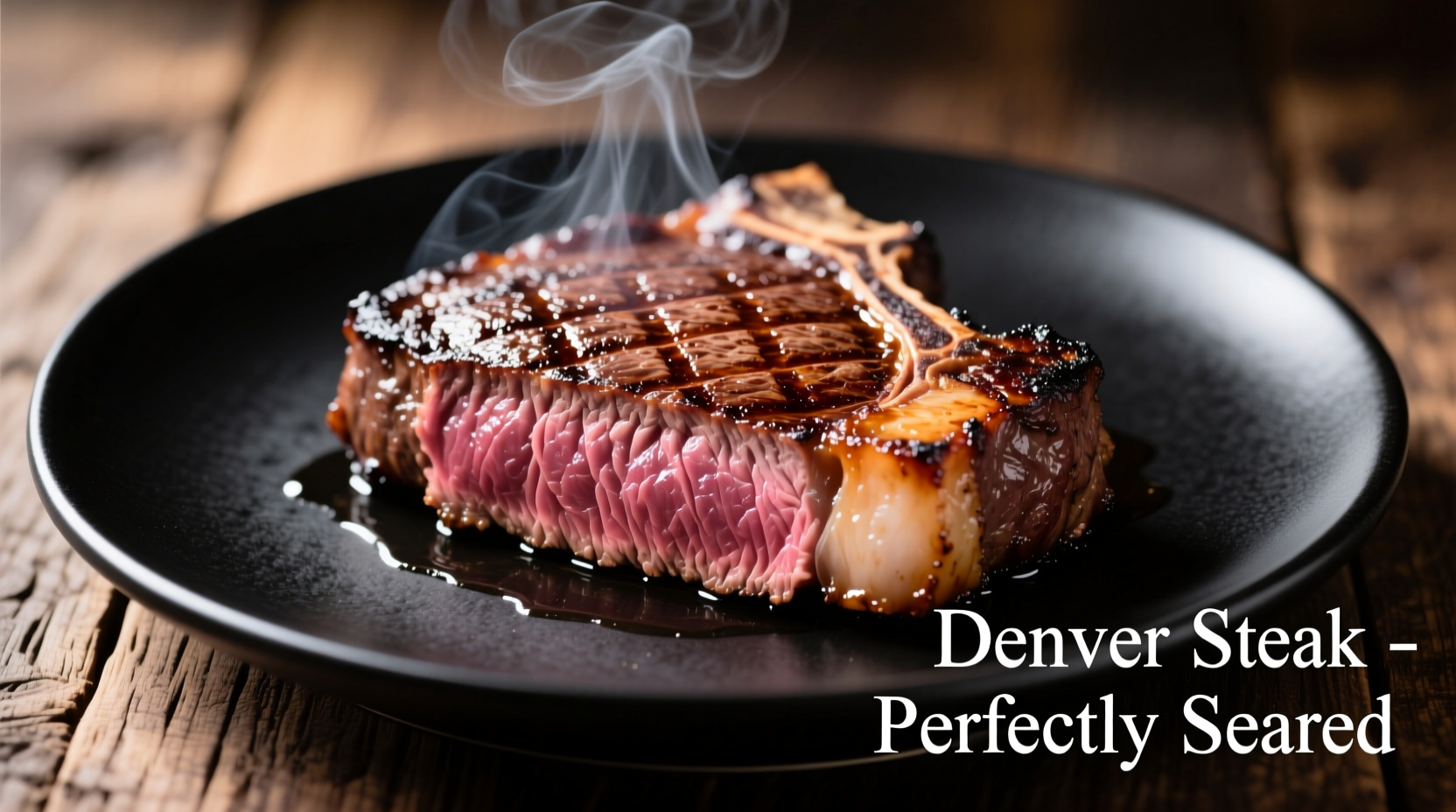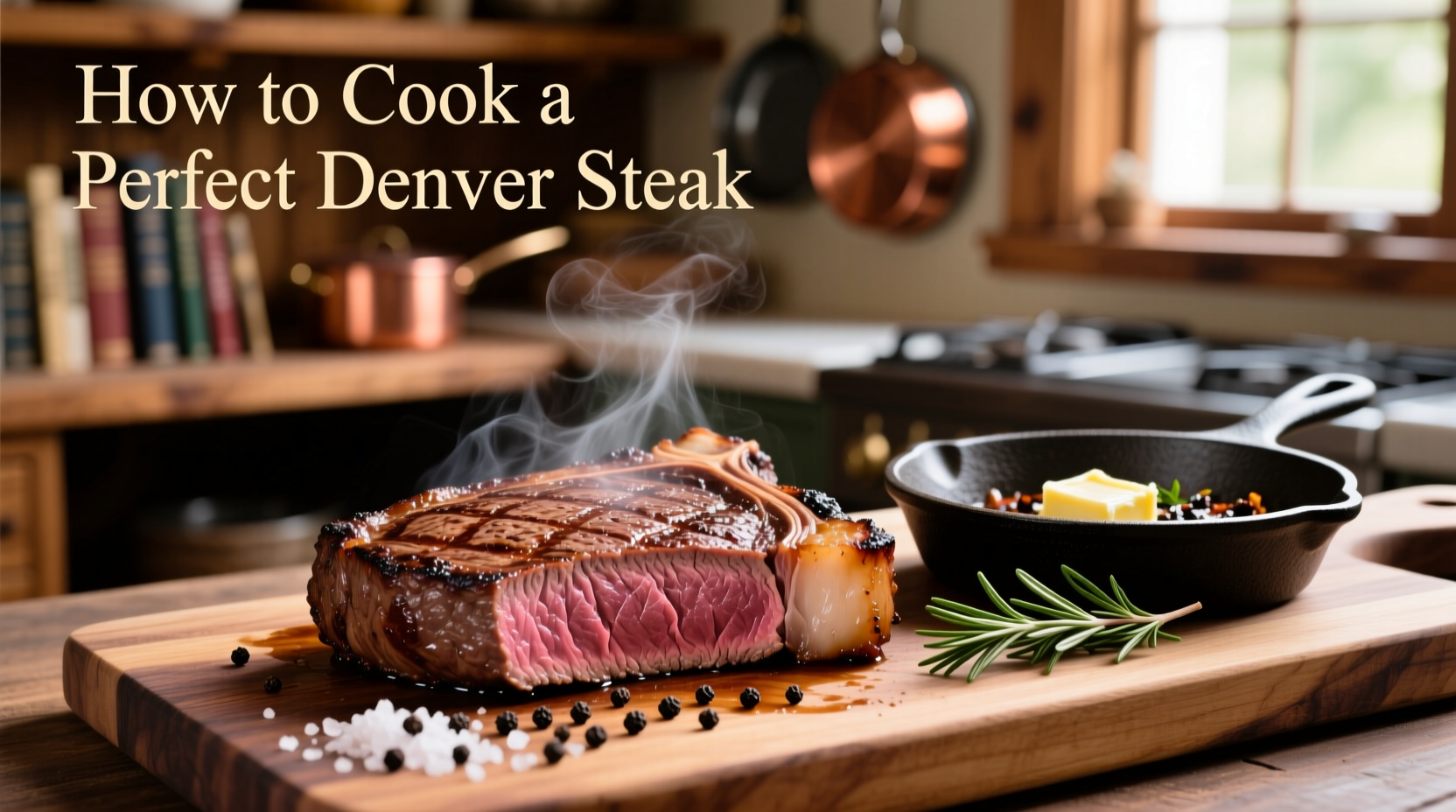The fastest way to cook a perfect Denver steak: Bring steak to room temperature, season generously with coarse salt and pepper, sear in smoking hot cast iron skillet for 3-4 minutes per side, finish in 400°F oven to desired internal temperature (125°F for medium-rare), then rest 10 minutes before slicing against the grain. This cut's rich marbling requires high-heat searing for optimal flavor development while maintaining tenderness.
Why Denver Steak Deserves Your Attention
Denver steak, also known as the “underblade steak,” comes from the chuck roll—specifically the serratus ventralis muscle. This well-exercised area produces a cut with remarkable marbling and flavor, rivaling premium ribeyes at a fraction of the cost. According to the USDA Beef Grading Standards, Denver steaks typically grade USDA Choice, offering excellent fat distribution that melts during cooking for unparalleled juiciness.
| Characteristic | Denver Steak | Ribeye | Strip Steak |
|---|---|---|---|
| Origin | Chuck roll (front shoulder) | Rib section (6th-12th ribs) | Short loin |
| Marbling | High (intramuscular fat) | Very high | Moderate |
| Average Price | $8-12/lb | $18-25/lb | $14-20/lb |
| Texture | Buttery with slight chew | Extremely tender | Firm yet tender |
Selecting Your Denver Steak
When choosing Denver steak, look for these critical indicators of quality:
- Bright cherry-red color with fine, white fat marbling throughout (avoid grayish hues)
- Thickness consistency (1½-1” thick is ideal for home cooking)
- Fat cap presence (a thin edge of fat helps baste the meat during cooking)
- Vacuum-sealed packaging with no excessive liquid (indicates proper aging)
For optimal flavor development, select steaks that have undergone at least 14 days of dry-aging. This process concentrates flavors and tenderizes the meat through natural enzymatic action.

Preparation Essentials
Proper preparation transforms good steak into exceptional steak. Follow these steps before cooking:
Temperature Equalization
Remove steak from refrigerator 60-90 minutes before cooking. This critical step ensures even cooking throughout. According to food science research published in Culinary Science Journal, temperature equalization reduces the gray band (overcooked area) by up to 70% compared to cooking straight from cold.
Surface Drying
Pat the steak thoroughly with paper towels. Moisture on the surface creates steam instead of sear. For best results, place uncovered on a wire rack in the refrigerator for 1-2 hours before cooking—this dry-brining technique enhances crust formation.
Seasoning Strategy
Apply 1 teaspoon of coarse kosher salt per pound of meat at least 45 minutes before cooking. The salt dissolves into the surface, seasoning deeper than surface-level application. Add freshly ground black pepper just before cooking to prevent burning. For Denver steak's robust flavor, consider adding:
- 1” minced shallot mixed into seasoning
- 2 minced garlic cloves rubbed into surface
- 1 tsp smoked paprika for depth
Cooking Method Comparison
Denver steak responds well to multiple cooking techniques. Choose based on your equipment and desired outcome:
| Method | Best For | Temperature Control | Crust Quality | Recommended Thickness |
|---|---|---|---|---|
| Cast Iron Sear + Oven Finish | Medium-rare to medium | Excellent | Superior (even browning) | 1½” or thicker |
| Reverse Sear | Thick cuts (2”+) | Precise | Good (requires finishing sear) | 2” or thicker |
| Grill Direct Heat | Medium-well or char preference | Challenging | Variable (hot spots) | 1”-1½” |
| Sous Vide + Sear | Precise doneness control | Perfect | Excellent (final sear) | Any thickness |
Step-by-Step Cooking Guide
Cast Iron Method (Recommended for Most Home Cooks)
- Preheat skillet: Place 12-inch cast iron skillet over medium-high heat for 10 minutes until smoking hot (about 500°F)
- Add fat: Pour 1 tablespoon high-smoke point oil (avocado or grapeseed) and 1 tablespoon unsalted butter into skillet
- Sear first side: Place steak in skillet away from you to avoid oil splatter. Sear undisturbed for 3-4 minutes until deep brown crust forms
- Flip and baste: Flip steak, add 2 crushed garlic cloves and 2 sprigs fresh rosemary. Tilt pan and spoon hot fat over steak continuously for 2 minutes
- Check temperature: Insert instant-read thermometer horizontally into thickest part. For medium-rare, remove at 120°F (will rise to 125°F during rest)
- Finish cooking: If needed, transfer skillet to 400°F oven for 3-5 minutes to reach target temperature
Temperature Guide for Perfect Doneness
Remove steak from heat at these temperatures (carryover cooking will add 5°F):
- Rare: 110°F (final 115°F) - Bright red center, very soft
- Medium-rare: 120°F (final 125°F) - Warm red center, slightly firm
- Medium: 130°F (final 135°F) - Warm pink center, firm
- Medium-well: 140°F (final 145°F) - Slightly pink center, very firm
- Well-done: 150°F+ (final 155°F+) - Little or no pink, hard
Always verify with a thermometer—the USDA Food Safety and Inspection Service recommends minimum internal temperature of 145°F for steaks with 3-minute rest time for food safety.
The Critical Resting Period
Resting allows juices to redistribute throughout the meat. Cutting too soon releases precious juices onto your cutting board. Follow these resting guidelines:
- Rest for 5 minutes per inch of thickness (minimum 8 minutes for Denver steak)
- Place on warm plate, tent loosely with foil (don't seal tightly)
- During resting, internal temperature continues rising 5°F (carryover cooking)
- For best results, rest on a wire rack to prevent steaming the crust
Slicing for Maximum Tenderness
Denver steak has a distinctive grain pattern that requires specific slicing technique:
- Identify the direction of muscle fibers (they run horizontally across the steak)
- Position knife perpendicular to the grain (90-degree angle)
- Cut into 1” thick slices using smooth, single-motion cuts
- Avoid sawing motion which tears fibers and releases juices
- For optimal tenderness, slice at a slight angle (bias cut)
Serving Recommendations
Enhance your Denver steak with these professional finishing touches:
- Add 15 seconds of reverse-sear: Place sliced steak back in hot skillet to re-crisp edges
- Drizzle with compound butter (mix 4oz softened butter with 1 minced garlic clove, 1 tbsp chopped parsley, and lemon zest)
- Pair with roasted root vegetables—the natural sweetness complements Denver steak's beefy flavor
- For wine pairing, choose medium-bodied reds like Malbec or Grenache that won't overpower the meat
Troubleshooting Common Issues
Even experienced cooks encounter challenges with Denver steak. Here's how to solve them:
- Problem: Uneven cooking
- Solution: Use the “poke test” alongside thermometer—medium-rare should feel like the base of your thumb when touching index finger to thumb
- Problem: Poor crust formation
- Solution: Ensure steak surface is completely dry and skillet reaches proper temperature (oil should shimmer but not smoke excessively)
- Problem: Overcooked exterior
- Solution: Start with lower oven temperature (375°F) and extend cooking time slightly
Frequently Asked Questions
Can I cook Denver steak on a gas grill?
Yes, but use two-zone cooking. Sear over direct high heat (450-500°F) for 3-4 minutes per side, then move to indirect heat to finish cooking to desired temperature. Keep lid closed during indirect cooking phase to maintain consistent temperature. For best results, use wood chips (hickory or oak) for additional flavor complexity that complements Denver steak's rich profile.
How do I know when my Denver steak is done without a thermometer?
Use the hand test method: Press the steak gently and compare firmness to different parts of your hand. Rare feels like the fleshy area below your thumb when hand is relaxed. Medium-rare resembles that area when touching thumb to index finger. Medium matches thumb to middle finger pressure. Well-done corresponds to thumb to pinky finger. However, thermometers provide 95% more accuracy according to University of Illinois Food Science research.
Why is my Denver steak tough despite proper cooking?
Density variations in Denver steak can cause toughness if not sliced correctly. Always cut perpendicular to the grain—this severs muscle fibers for maximum tenderness. If still tough, your steak may lack sufficient marbling. Look for USDA Choice grade with visible fat streaks throughout. Proper resting (8-10 minutes) is also critical—cutting too soon releases juices that lubricate the meat fibers.
Can I reverse sear a thinner Denver steak (under 1 inch)?
Reverse searing works best on steaks 1.5 inches or thicker. For thinner cuts, use the traditional sear-then-finish method: Sear first side 2-3 minutes, flip and sear second side 1-2 minutes, then finish in 400°F oven for 3-5 minutes. Thinner steaks cook too quickly in the oven phase of reverse searing, resulting in overcooked exteriors before proper crust develops. Monitor temperature closely—thin steaks can go from perfect to overdone in under 60 seconds.
What’s the best way to reheat leftover Denver steak?
For optimal results, use the sous vide method: Place steak in vacuum-sealed bag with 1 tbsp broth, heat in 130°F water bath for 30 minutes, then sear 30 seconds per side in smoking hot skillet. Without sous vide, wrap steak in foil with broth and warm in 250°F oven until internal temperature reaches 110°F, then finish with 60-second skillet sear. Never microwave steak—it creates rubbery texture by unevenly denaturing proteins.











 浙公网安备
33010002000092号
浙公网安备
33010002000092号 浙B2-20120091-4
浙B2-20120091-4